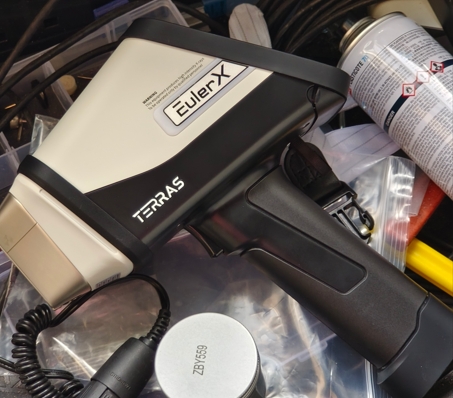
Gold and Jewelry
A high-tech enterprise focusing on the development and application of X-ray technology products, committed to becoming a leading supplier of X-ray industrial testing solutions.
Maximizing the Accuracy of Your Portable Gold Analyzer: Tips and Tricks
When it comes to precious metals like gold, accuracy is paramount. Whether you're in the field testing ores or analyzing jewelry in a store, having the right equipment and knowing how to use it effectively can make all the difference. Portable gold analyzers have revolutionized the way professionals assess gold purity and authenticity, but their performance depends on how well they are calibrated and operated. In this blog, we’ll explore practical tips and tricks for maximizing the accuracy of your portable gold analyzer to ensure precise results every time.
1. Proper Calibration is Key
One of the most essential steps in ensuring your portable gold analyzer provides accurate readings is calibration. Over time, analyzers can drift from their original settings due to wear and tear or environmental conditions. Always ensure that your device is calibrated regularly according to the manufacturer’s instructions. Calibration kits are usually included with the analyzer, but if not, they can be purchased separately.
Before every use, calibrate your analyzer with known gold samples or certified calibration standards to eliminate any discrepancies that may arise from environmental factors, such as temperature or humidity.

Terras Handheld XRF EulerX900 Precious Metal Analyzer
2. Understand the Limitations of Your Analyzer
Portable gold analyzers come in different types and models, each with its strengths and weaknesses. Some may be optimized for jewelry, while others are designed for raw gold ore or scrap metal. It’s important to understand the specific capabilities and limitations of your device. For example, if your analyzer is designed to measure gold purity using X-ray fluorescence (XRF), it may not be suitable for testing gold alloyed with certain metals. Knowing what your device is best suited for will help you achieve more accurate readings.
3. Ensure Clean Sample Surfaces
The accuracy of your results can be significantly affected by the surface condition of the sample you’re analyzing. Dirt, oil, or oxidation on the surface of the gold will interfere with the analyzer’s readings. Always clean the sample thoroughly before conducting any analysis. Use a soft cloth or appropriate cleaning solution to wipe off any impurities, ensuring that only the pure gold surface is exposed.
4. Take Multiple Measurements
For better accuracy, especially when testing raw or irregularly shaped gold samples, take multiple readings at different locations on the sample. Gold nuggets or jewelry might have inconsistencies in purity across their surface. By conducting several measurements, you reduce the chance of getting skewed results from a single test.
5. Consider Environmental Factors
Portable gold analyzers are sensitive to environmental conditions such as temperature, humidity, and even electromagnetic interference. These factors can impact the device’s performance. Whenever possible, perform your analyses in stable, controlled environments.
If you’re working outdoors or in conditions with fluctuating temperatures, allow your analyzer to acclimate to the environment before starting the test. Avoid using the analyzer in direct sunlight or in extremely humid conditions, as these may affect the accuracy of your readings.
6. Proper Training and Technique
How you handle the analyzer can make a significant difference in the quality of your results. Make sure you are familiar with the device’s operation, and follow any guidelines provided by the manufacturer. For example, ensure that the probe or sensor is properly placed against the sample. An improper angle or insufficient contact could result in inaccurate readings.
Additionally, when using an XRF-based analyzer, ensure that the instrument is held steady during the analysis process. Any movement can lead to faulty readings or inconsistent results.

Terras Handheld XRF EulerX900 Precious Metal Analyzer
7. Monitor Battery Life
A low battery can reduce the effectiveness of portable analyzers and compromise their ability to generate accurate results. Always ensure that your device is fully charged before use, and carry extra batteries or a portable charger if you’re working in remote locations. Some analyzers also have battery-saving modes that can affect performance, so be aware of these settings and adjust them accordingly.
The EulerX 990 is a cutting-edge handheld gold analyzer equipped with a ceramic packaged microfocus X-ray tube and a high-performance semiconductor detector. Utilizing advanced software algorithms, it can perform quick, accurate, and non-destructive testing of gold, silver, platinum, and other precious metals in jewelry, enabling the rapid identification of their purity. This makes the EulerX 990 an essential tool for assessing the quality of jewelry, investment gold, and other precious metal commodities.
Conclusion
Maximizing the accuracy of your portable gold analyzer is essential for ensuring that you make informed decisions, whether you’re working in a professional laboratory or out in the field. By properly calibrating your device, understanding its limitations, and following best practices for sample preparation, you can achieve consistently accurate readings. Regular maintenance, environmental awareness, and using complementary methods for verification will further enhance the reliability of your analyzer. With these tips and tricks, you’ll be well on your way to extracting the most accurate data from your portable gold analyzer every time you use it.
Join Us
Subscribe to our email list for updates & promotions.



